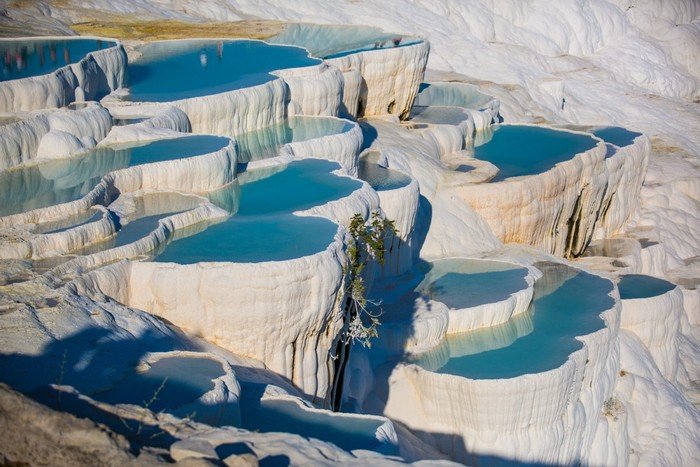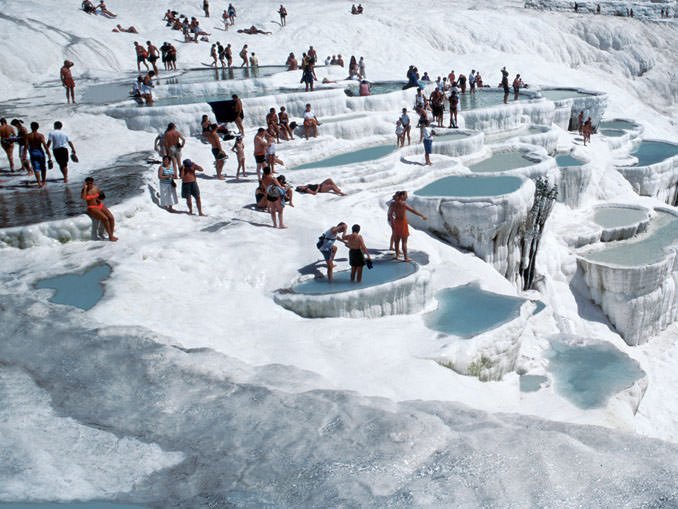meaning “cotton castle” in Turkish, is a natural site and attraction in south-western Turkey in the Denizli Province. The ancient city of Hierapolis was built on top of the white “castle” which is in total about 2700 meters long and 160m high. It can be seen from a great distance, eg. when driving down the hills on the opposite side of the valley to the town of Denizli, which is 20 km away. Pamukkale is located in Turkey’s Inner Aegean region, in the River Menderes valley, which enjoys a temperate climate over the greater part of the year.

The tectonic movements that took place in the fault depression of the Menderes river basin did not only cause frequent earthquakes, but also gave rise to the emergence of a number of very hot springs, and it is the water from one of these springs, with its large mineral content — chalk in particular — that created Pamukkale. Apart from some radioactive material, the water contains large amounts of hydrogen carbonate and calcium, which leads to the precipitation of calcium bi-carbonate. The effect of this natural phenomenon leaves thick white layers of limestone and travertine cascading down the mountain slope resembling a frozen waterfall.

PamukkalePamukkale is a famous tourist attraction of Turkey. Tourists travel from the coast of Antalya and the Aegean Sea to Pamukkale as it is one of two World Heritage Sites in Turkey, together with Hierapolis. Only a few other places in the world resemble it, including the Mammoth Hot Springs in the USA and Huanglong in Sichuan Province of China (another UNESCO World Heritage Site). Hierapolis-Pamukkale was made a World Heritage Site in 1988. The ruins of Greek temples and baths can be seen here.

Before the World Heritage designation, Pamukkale went unprotected for decades in the late 20th century and hotels were built on top of the site, destroying parts of the remains of Hierapolis. Hot water from the springs was taken to fill the hotel pools and the waste water was spilled over the monument itself, turning it brownish. A tarmac road ramp was built into the main part. People walked around with shoes, washed themselves with soap and shampoo in the pools and rode bikes and motorbikes up and down the slopes. By the time UNESCO turned its attention to Pamukkale, the site was losing its attraction. Officials made attempts to restore the site. The hotels were demolished, and the road ramp was covered with artificial pools which today are accessible to bare-footed tourists, unlike most other parts of the site. Tadpoles can be found in the pools. A small trench was carved along the outside of the ramp to collect the water and prevent it from spilling. The brownish parts have been left to be bleached by the sun without being covered by water to lessen the problem. Many pools are thus empty. Others parts are covered with water for an hour or two according to a schedule which is on display on top of the hill.
The underground volcanic activity which causes the hot springs also caused carbon dioxide to seep into a cave which as a result was called the Plutonium meaning place of the god, Pluto.
a place you should definitely go and see



https://mavikoku.wordpress.com/2013/12/18/pamukkalenin-ingilizce-tanitimi/
Source- https://mavikoku.wordpress.com/2013/12/18/pamukkalenin-ingilizce-tanitimi/
Not indicating that the content you copy/paste is not your original work could be seen as plagiarism.
Some tips to share content and add value:
Repeated plagiarized posts are considered spam. Spam is discouraged by the community, and may result in action from the cheetah bot.
If you are actually the original author, please do reply to let us know!
Thank You!
More Info: Abuse Guide - 2017.
Hi! I am a robot. I just upvoted you! I found similar content that readers might be interested in:
https://mavikoku.wordpress.com/2013/12/18/pamukkalenin-ingilizce-tanitimi/
It really looks like paradise..
one of my favourite place in earth!